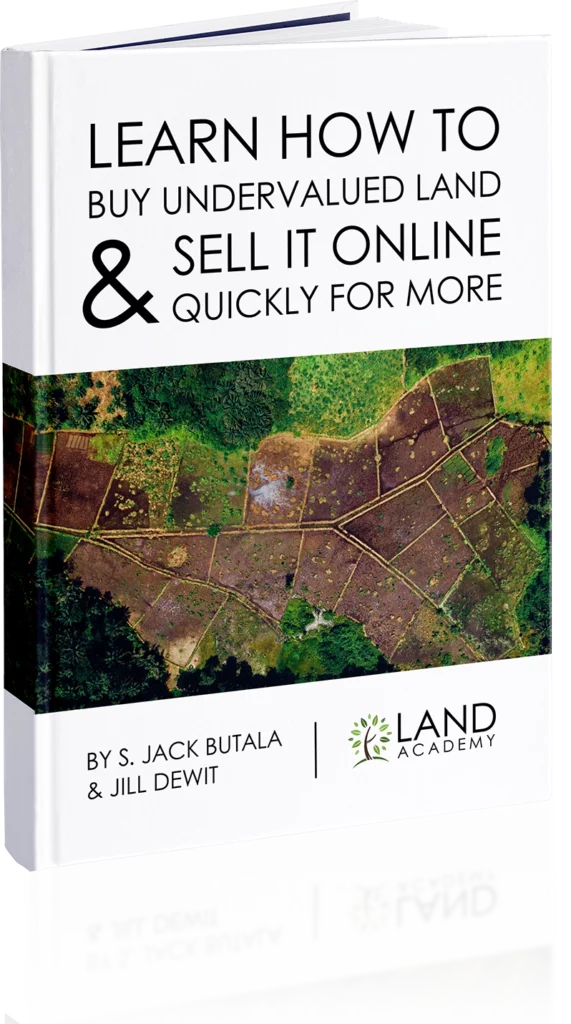8 A’s Of Land Investing
All week this week, we are talking about the eight A’s that make up the due diligence portion of your land business. Today, we are talking about Attributes.
We are on day 4 of 5. Today is Thursday. On Monday, we discussed Affordable. On Tuesday, we did Access and Adjacent. Yesterday, we did Acreage. Today, we’re going to talk about Attributes. Tomorrow, we will give you numbers 6, 7, and 8, which are Alive, Abundance, and Afraid. As Jack said, this all started with Jack probably 20 or 30 years ago. He came up with these A’s as a way to make sure that you’re making good acquisition decisions. Probably because acquisition starts with an A. You have an A thing. I like it.
You need an acquisition criteria, a model of what the perfect property is.
You need to make sure that it’s a good property. By having these eight A’s, it’s your little checklist to make sure you’re making good decisions.
Buying And Selling A Piece Of Land
Each day on the show, we answer a question from our Land Academy member Discord forum and take a deep dive into land-related topics by popular request.
Mike wrote, “Can you describe the process of buying and selling a piece of land from the very beginning to the end? How is it different from flipping a house?” I could do this. Give me an hour. Just kidding. Do you want to go first?
Sure. Step 1) You establish your acquisition criteria and how much money you want to make that month and that year. We use the Equity Planner for that. Now you have an acquisition criteria and a gauge about how much money you want to make. Most people never make it past this point. You don’t need to be a member of Land Academy.
Sit down with a piece of paper and say, “I want to make a couple of hundred thousand dollars this year. I want to do twelve deals. I know that it takes 8,000 to 10,000 mailers to generate one deal to fulfill that type of acquisition.” How much mail do I need to send X amount of mail? That’s it. You don’t need a tenth-grade education. You don’t need anybody or anything other than a piece of paper and a pencil to figure that out. If you don’t do it, you’re flying blind. That’s number one.
Step 2) You need to start to look around on the internet for places in the country that allow you to fulfill your acquisition criteria goal and the financial goal that you established in step one. We call it trolling. You do that. Number 3) You find places that seem to work based on our trolling methodology, and you test them. You don’t guess. You don’t think, “Central Wisconsin is a fantastic place, so I’m going to send mail there and try it and see what happens.” You test those ZIP codes to make sure that what’s happened there in the past fulfills your acquisition criteria in number one.
The next step, number 4) You send mail out there. You send mail. You do a mailer. You send blind offers that are priced correctly within reason, and you expect a certain number of responses to fulfill that acquisition criteria in number one. 5) You manage the inbound or influx of responses to your mailer. This is where I bow out and Jill takes over. She’s thinking about something else. What are you thinking about? Are you enjoying the weather?
I am. I figured you were going to take the whole question, so I’m letting you run with it. It’s okay. You’re doing a good job.
It’s early October. It’s 30 degrees. It’s Jill’s favorite time of year.
I love fall.
We mulled local cider.
By the fire.
Some of us put some vodka in it. By the fire outside.
Some of us put some maple whiskey from Canada in it. I wonder who’s who.
Jill’s happy when we’re not talking about acquisitions.
Especially because it’s 100 degrees back in Arizona. I’m not going there anytime soon.
You’re managing the influx of offers. We can do that because of these eight A’s. Managing the influx of offers, Jill does that on the phone. She creates real estate deals. She picks up where I left off. I make her phone ring. I jam her pipeline full with the acquisition opportunities. She picks the 2, 3, or 4 a month, or whatever it ends up being for you that she loves. She creates a real estate deal. The rest from start to finish involves buying actual property. Jill has staff for that. Our Land Academy Pro members use our staff to do it for their own deals.
They’ll get the deal done for you.
She buys it and then resells it. There are little steps in between. That’s what the Land Academy program is all about, filling in, and answering all your questions in the tiny details.
The difference between flipping a house is, first of all, the way that we do houses is we’re not doing any renovations. We are buying them and selling them in their current condition. The biggest difference is you have to have eyes on it. You’ve got to have inspections. There are other things. You need to know what you’re getting into. You’re not going to do the numbers that we do. You’re not going to double your money on a house. That’s not the goal. We’re going to make sure that you make whatever your minimum is. I’m not going to do a house unless I make $100,000. You back into it that way for pricing, which is a lot different.
The difference from flipping a house for us is that the asset of the house needs a lot of attention. It’s a regular occurrence for us to buy and resell successfully a piece of land without ever seeing it at all. That’s part of the business model.
The same thing with we don’t visit land properties. We don’t visit the houses, but somebody does on the house one.
Inspector and boots on the ground.
Somebody has eyes on it, making sure that the foundation is not a cracked mess.
On the data side, we send an offer out that’s based on the individual asset to flip the house. If the internet believes the house is worth $180,000, we send out an offer for less, depending on how much money we want to make. We line item by line item by line item and price them that way. It’s not hard. It’s very mechanized.
Good question, Mike.
Attributes
We’re talking about the eight A’s, as Jill said at the beginning of the episode. Today is Attributes.
This is fun. The easiest way to think about this one is the minute this property comes in, and the minute, the instant you have a spark like, “I need to buy this because,” fill in the blank, that’s it. It’s like, “Wow look what’s around here,” or “Wow, look at that creek,” or “Wow, look at those trees.” “Wow, it is smack downtown next to a Dollar Tree. This thing is going to be worth some dough.” You’re uncovering the attributes there.
Attributes are distance, physical things, beauty, maybe zoning, and what’s possible. There are all kinds of things that can be an attribute. Those attributes are A) How you remember the property. When I would do the selling, when I would, by myself, answer all the calls for all the sellers and all the buyers, that would be how I remembered the property like, “The one with the pond. Isn’t that beautiful?” That’s how I remember the property, and then B) That’s what you put in your description, “Beautiful pond, investor special, 20 acres, 3 miles from fill in the blank city.” Back then, we’d write our own descriptions and things, and we were selling them. That’s your attribute. That’s what pulls you in. What pulls you in is going to pull your buyer in. You highlight those attributes.
Three things can happen when you’re reviewing your acquisition candidate for attributes. By the way, I believe Attributes is one of the easiest A’s to determine very quickly on the internet, within a minute. The first possibility, it’s what Jill said, there’s a stream running through it, all the trees are still intact, or something is amazing about it. Check, it passes. Everybody wants that. Everybody wants a stream running through the back and a little driveway that drives up to it like it’s a Disney scene.
The second possibility is nothing. It doesn’t have any attributes. It’s out in the middle of nowhere. You can get to it, and we got this far because it passed the access test. We’re looking at it and saying, “It’s a great property, it’s passing all the tests, but it is out there.” Its only use is probably going to be recreation.
That could be the attribute then. Thank goodness it’s 40 acres. People will love that.
In its current spot, it doesn’t have any attributes. It has potential. The third possibility, and you want to run away when this happens, is it used to be the town dump. There used to be a gas station on it. It’s next to a nuclear power plant, or some negative attribute. That’ll kill the deal. A deal-killing attribute. You’re not testing a property for a Disney scene. Jill always looks on the bright side of it.
Look at the deer.
You want to, all kidding aside, look at it and see if maybe they used to drill oil there and they don’t anymore. You do not want an EPA property.
Can I tell a funny story real quick? This is so funny. I have to pause here. We were looking at a property, like Jack said, we were in the Pacific Northwest. Everywhere you look is magical. It’s fall. It’s like every day is a Chamber of Commerce day, as Jack calls it. It’s hilarious. We’re walking this property. Beautiful apple tree. I’m looking and there’s deer everywhere. You turn around the corner and it’s like, “Excuse me, there’s a deer right there.” There’s deer poop everywhere. We happen to be walking with a woman in the neighborhood. She sees what we’re doing and wanders over. She’s pointing out the different poop and pointing out like, “That’s bear.” It’s making me look at things. That could be an attribute. Bear and deer frequent your property.
It’s an attribute for Jill, I’ll tell you that.
It is an attribute for me, it’s true. Not grizzly, black.
This property had a bunch of apple trees on it. It was an attraction for wildlife in the area.
They want that. That’s good. They’re bulking up for the winter. That’s totally what’s going on.
To summarize, a lack of attributes is not necessarily a deal killer. If you do have a bunch of properties that you’re looking at, which we’ll talk about tomorrow, Abundance, and one of them has amazing attributes and another one doesn’t, it pushes that property ahead on your acquisition schedule. They’re fun. Attributes are why we’re in this. Attributes are why we all go gaga over real estate. Think about a house. Think about attributes when you’re buying and selling a house. That’s what HGTV is all about.
It’s done. That’s an attribute. It was remodeled a year ago.
If you’ve ever watched Property Brothers, which cracks me up, those two guys walk through a house that needs to be renovated with the potential new owners. One of the first things that the new owners say is, “I hate this wallpaper.” The two brothers are pretty serious smartasses about it, “No, we can’t change that.” “Why is this wall here?” “I don’t know. We can’t tear that wall down.” They’re so tired of it after how many years or whatever. Attributes are important with everything. Hopefully, the person you’re married to has some positive attributes.
I hope so. Maybe.
It’s a little too late. If you didn’t review your spouse for the eight A’s.
Tomorrow is Friday. Here’s what we’re going to do as we’re ending the show on Thursday. We’re going to each write down four A’s that you should have in a relationship.
I think you should have all eight A’s.
Let’s do this. We’re going to make it four relationships A’s. Alive can be one of them. I love it. Tune in tomorrow because we’re going to each share our list, but we’re going to keep them a secret until tomorrow when we’ll reveal them to you.
This is good.
You are not alone in your real estate ambition.
We are Jack and Jill. Information and inspiration to buy undervalued property.















